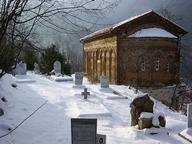Quiz Answer Key and Fun Facts
1. Bulgaria is the land of the Bulgars, a nomadic tribe from the northern Black Sea. However, a part of the tribe led by Asparukh eventually conquered the area where Bulgaria is now. What title, perhaps inspired by Kublai or Genghis, did Asparukh take for himself?
2. Bulgaria shares a border with five countries: Turkey, Greece, North Macedonia, Serbia and Romania. Which of the five shares the shortest border with Bulgaria, in length and in years?
3. Ruse is a very important port on a river, the second-longest river in Europe. On the bank of which river, immortalized in a waltz by Strauss, is Ruse built?
4. Bulgaria has land borders on three sides except in the east, where it borders on a sea. Which sea makes up Bulgaria's eastern border?
5. Stara Zagora is Bulgaria's sixth-largest city, the capital of the province bearing the same name. While the city itself dates back to 342 BCE, which culture, one that ruled over most of Bulgaria in the 5th century BCE, founded the settlement and coined its original name, Beroe?
6. Bulgaria is an area of rich fertile lands, rolling and undulating expanses, gentle rivers, all of these going down to a pleasant coast. What type of terrain makes up most of Bulgaria?
7. The capital of the country, Sofia, has been around for a while, in fact, humans have lived there for over 9,000 years! Which of these names did it NOT possess during that time?
8. My grandmother told me that if I was to visit Bulgaria, I have to go to the banya at Burgas. Bulgaria has many banyas all over. In Burgas, the Romans built one which grew to become a town called Aquae Calidae. What is a banya?
9. Musala is a peak in Bulgaria that is the highest point in the country. It is so tall, 'really' tall, that it is the highest peak in the entire Balkan Peninsula. What mountain range is it a part of?
10. The second-largest city in Bulgaria is Plovdiv, located in the south-central part of the country. Though settlements existed there before, it was officially founded by Philip the Great of Macedonia back in 342 BCE. What name did he give this ancient city?
Source: Author
LeoDaVinci
This quiz was reviewed by FunTrivia editor
agony before going online.
Any errors found in FunTrivia content are routinely corrected through our feedback system.
